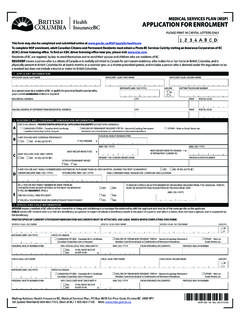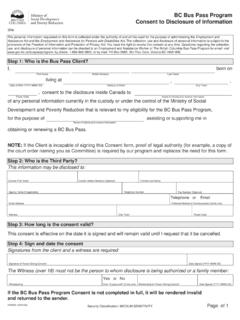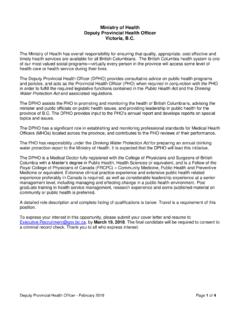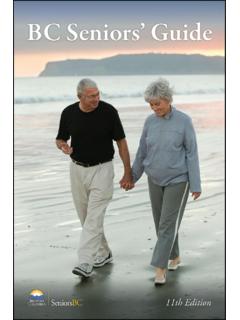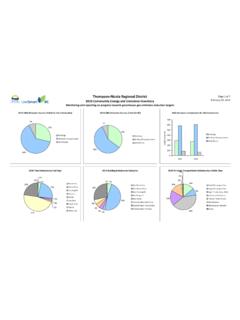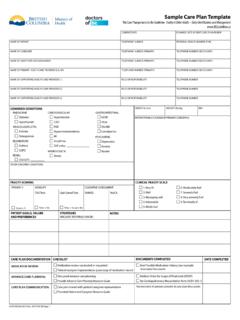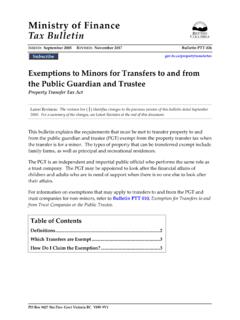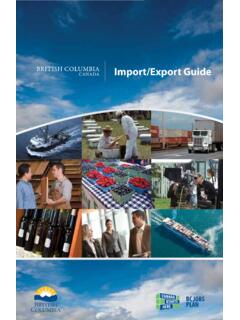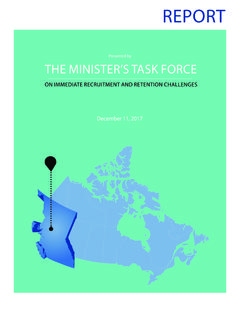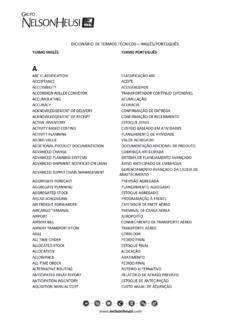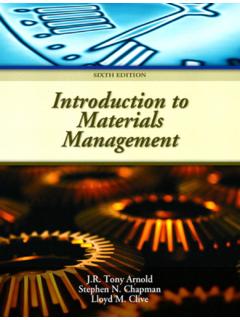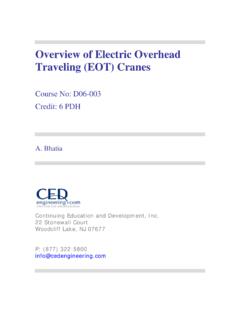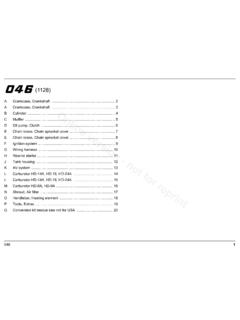Transcription of A Field Guide to Fuel Handling, Transportation & Storage
1 A Field Guide to fuel Handling, Transportation & Storage 3rd Edition, February 2002. Ministry of Water, Land and Air Protection INTRODUCTION. This document provides guidance on acceptable industry practice for managing fuel handling, Transportation and Storage in rural and remote areas of British Columbia. It summarizes requirements of applicable statutes of Canada and British Columbia, industry codes of practice and recommendations relating to environmental protection, health and safety, and fire protection. This document provides general guidance; however, it is not intended to address every type of fuel facility. It is the responsibility of each commercial or industrial operator to implement the statutory requirements for which they are responsible. While this document refers to legislation in effect on the date of publication and proposed legislation, users should always reference the current piece of legislation for accuracy of legal requirements.
2 To assist the user: (1) terms or phrases that are defined in the Section 11. Glossary are italicized in the text of this document; and, (2) legislated requirements and recommendations are separately highlighted throughout the document as follows: n Denotes statutory requirements of legal documents, such as the BC Fire Code and the Transportation of Dangerous Goods Regulations, with text references.. q Denotes recommended practices.. Nothing in this document should be construed as waiving compliance with any applicable statutory or other legal requirement. ACKNOWLEDGMENTS. The Ministry of Water, Land and Air Protection and the Ministry of Forests acknowledge: Vern Atkinson, Regional Fire Commissioner, Victoria; Ray Hollenberg, NorthWest Response Ltd., Smithers; Bernard A. Bintner, Environmental Management Branch; and Canadian Forest Products Limited (CANFOR) for their contribution toward the development of this document.
3 TABLE OF CONTENTS. Section 1. SMALL CONTAINERS = 230L Canisters, Jerry Cans, Pails, Drums ..1. DESIGN ..1. OPERATIONS ..1. Spill Safety Awareness ..1. Emergency Response ..2. Remote Storage Transportation ..2. Load DOCUMENTATION & Training ..3. Section 2. SMALL TDG TANKS < 454L Truck-Box fuel DESIGN ..5. OPERATIONS ..5. Spill Control & Secondary Containment ..5. Safety Awareness ..5. Emergency Response ..7. Transportation ..7. Load Training ..7. Section 3. LARGE TDG TANKS > 454L Tank Vehicles ..9. DESIGN ..9. Tank Trailers & Semi-Trailers ..9. OPERATIONS .. 10. Spill Control & Secondary Containment .. 10. Safety Awareness .. 10. 11. Emergency Response .. 12. Transportation .. 12. Load 12. DOCUMENTATION & 13. TDG 13. 13. Training and Signage .. 13. Section 4. FIXED LOCATION ABOVEGROUND Storage TANKS (AST) > 230L.
4 14. DESIGN .. 14. 15. OPERATIONS .. 15. Spill Control & Secondary Containment .. 15. Safety Awareness .. 15. 16. Pollution Prevention .. 17. Emergency Response .. 17. DOCUMENTATION & 17. Inspection & Documentation .. 17. Training and Signage .. 18. Section 5. MARINE FACILITIES foreshore facilities, wharves, docks, floating structures, barges and boats .. 19. DESIGN .. 19. Siting 19. OPERATIONS .. 20. Spill Control & Secondary Containment .. 20. Safety Awareness .. 21. 21. Pollution Prevention .. 22. Emergency Response .. 22. DOCUMENTATION & 23. Inspection & Documentation .. 23. Training and Signage .. 23. Section 6. SECONDARY CONTAINMENT & COLLISION PROTECTION .. 24. Secondary Containment .. 24. 24. Discharge of 24. Collision 25. Section 7. RISK 26. Table Risk-Ranking for Land-Based fuel Facilities .. 26. Table Recommendations on Risk Control Measures.
5 27. Section 8. TREATING HYDROCARBON CONTAMINATED SOILS .. 28. 28. Polluted or Contaminated Soil Remediation .. 28. Contaminated Soil 28. Preparing a 29. Preparing a Biocell .. 29. Adding Nutrients .. 29. Disposal of Remediated Soil in British Columbia .. 29. Section 9. SPILL 30. Initial Spill Identification, Notification and Assessment .. 30. Initial Spill Response for Combustible 31. Spill Response Equipment .. 32. Section 10. STATUTES, INDUSTRY STANDARDS & CODES OF PRACTICE .. 34. Section 11. GLOSSARY .. 36. Section 12. CONTACTS .. 40. Section 1. SMALL CONTAINERS = 230L. This Guide is meant to assist Field operators in reducing the risk and environmental impact where flammable or combustible liquids (See Section 11. Glossary.) are handled, transported and stored. It provides statutory requirements and recommended practices for preventing fires and enhancing health, safety and environmental protection.
6 Section 1. SMALL CONTAINERS = 230L Canisters, Jerry Cans, Pails, Drums Statutory Requirements & Recommended Practices DESIGN. (See definition of small container in Section 11. Glossary.). n Containers = 230L, used to store flammable or combustible liquids ( , gasoline & diesel fuel ), must meet the appropriate design specification. ( ). q Maintain containers in good condition not damaged, rusting or leaking. q Adequately seal containers with proper fitting lids, caps, bungs or valves to prevent spills and leaks. OPERATIONS. Spill control Note: Secondary containment is not required for individual small containers n Spill control is required for small containers of flammable and combustible liquids that have the potential to spill. (FC ). q The degree of spill control should be based on the level of risk. (See Section 7.)
7 Risk Assessment.). Safety Awareness n All fuel containers must be labelled in accordance with the Workplace Hazardous Materials Information System (WHMIS), and according to the Fire Code. (FC ). n Smoking is not permitted where dispensing is being carried out. (FC ). n One 20-B:C rated fire extinguisher or two 10-B:C rated fire extinguishers are required where containers are stored within a building or structure. (FC & FC ). q Signs should be displayed where Storage ( , fuel cache) or dispensing takes place. Dispensing n Maintenance and operating procedures shall be established to prevent spills. (FC ). n Containers must not be filled beyond their safe filling level. (FC ). 1. Bullets: n Statutory Requirements Symbols: less than (<) Abbreviations: meter (m). greater than (>) litre (L). q Recommended Practices equal to or less than (=) kilogram (Kg).
8 Equal to or greater than (>). Section 1. SMALL CONTAINERS = 230L. Statutory Requirements & Recommended Practices q Mark containers at a safe maximum fill level corresponding to approximately 90% capacity. q Use an electric fuel pump when dispensing from a drum . When an electric fuel pump is not available or not practical, use a manual pump. Always store and secure the fuel hose above the drum to prevent siphoning. q Ensure that dispensing procedures are clearly outlined and posted where all operators can see them. q Keep the drum upright; avoid dispensing from a horizontal drum . q Ensure housekeeping is effective in maintaining a clean and tidy facility. Emergency Response n Spills of TDG Class 3 flammable liquids > 100L must be reported to the Provincial Emergency Program (PEP). telephone 1-800-663-3456). (WMA, Spill Reporting Regulation see definition of TDG Class 3 flammable liquids in Section 11.
9 Glossary.). n Ensure that spills are recovered and that all contaminated soil is removed or treated. (FC ). q Post initial spill response procedures with truck or fuel cache. (See Section 9. Spill Response.). q Maintain a spill response plan and a kit capable of containing and absorbing fuel spills. (See Section Spill Response Equipment.). Remote Storage Locations q Forestry landings must not be closer than 30 m to a stream to ensure that the landing provides sufficient buffer for sediment, ash and fuel spill infiltration. (FPC Community Watershed Guidebook 4, Section ). q Assess and manage the risk potential at all remote fuel cache locations. (See Section 7. Risk assessment.). q Ensure all empty containers are removed from remote locations and returned for refilling or recycling. Transportation . Note: TDG documentation is not required when the total fuel capacity of all the containers on the vehicle is = 2000L.
10 (TDG ). Load Security n No person shall drive or operate on a highway a vehicle carrying a load unless the load is secured in a manner which ensures that: the load will not escape from the vehicle the load will not shift or sway in a manner that may affect the operation of the vehicle. (MVA Division ). 2. Bullets: n Statutory Requirements Symbols: less than (<) Abbreviations: meter (m). greater than (>) litre (L). q Recommended Practices equal to or less than (=) kilogram (Kg). equal to or greater than (>). Section 1. SMALL CONTAINERS = 230L. Statutory Requirements & Recommended Practices n No person shall drive or operate a commercial vehicle on highway while the vehicle is carrying drums or barrels on end unless: where metal drums or barrels are stacked on end, or on other metal drums or barrels, the stacks are separated by dunnage; and, the vehicle has sides, sideboards or side stakes and the drums or barrels are blocked or tied down with hardware adequate to prevent the load from shifting on the vehicle.
